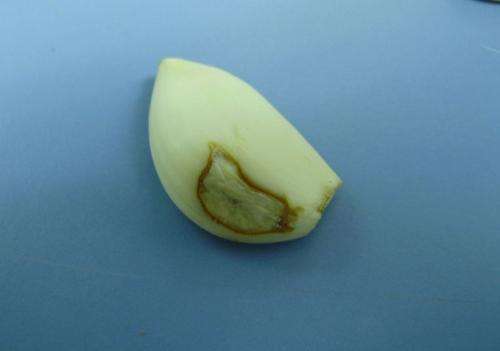New keys to control garlic rot

Researchers at the UPM have revealed decisive aspects to address the control of the fusariosis, a disease caused by garlic rot during storage.
After finding the causal agent of garlic rot, the Professor Daniel Palmero along with his team of Plant Protection Department of the College of Agricultural Engineering in collaboration with Coopman, have studied to fight against this disease. In the last three years, they have analyzed the influence of multiple aspects in rot development and the final crop yield. Those findings will allow researchers to improve protocols for the control of this disease.
Garlic (Allium sativum L.) is a species of major importance in the region of Castilla la Mancha (Spain), particularly in Albacete (4900 inhabitants) and Cuenca (2632 inhabitants) where there is an average production of garlic of 8,000 kg/inh what it means 40% the national production approximately. The garlic crop is not only a substantial source of wealth for the region but it is also part of its cultural and natural heritage.
In this sense, there are others research concerned about the quality of the final product, they are previous studies in which the species Fusarium proliferatum was determined as a casual agent of garlic rot during the post-harvest: drying, conditioning and storage.
The Professor Palmero along with his group are conducting a research in collaboration with Coopaman S.C.L, a company of Cuenca made up of 6 cooperatives which commercialize garlic, to fight this disease.
Diverse projects allowed researchers to study the possible pathogens and how these funguses might affect other crops of the area (onions, leeks and corns), the relationship of soil temperature during the crop over the future apparition of rot when storage, the varietal sensitivity to rot or the effect of fungicide treatments of pre-planting on disease control in the field.
The fight against Fusarium bulb in the planning of fungicides in soils during campaign had not taken into consideration so far. The researchers have studied in vitro and they are currently working on-site the effect of diverse fungicide treatment and the temperature of thermotherapy. The temperature during storage was another aspect studied, they found how this factor can be the key to manage the disease.
These findings allowed researchers to identify strains carrying of key gene in the biosynthesis of fumonisin and mycotoxin-producing strains such as fusaric acid. Besides that, there are numerous isolated microorganisms and diverse methods used to study its morphological, physiological and molecular characterization. And, even though those microorganisms were just isolated in a constant way in all the samples of garlic analyzed, it cannot rule out a certain effect of the rest of isolated microorganisms over the pathology.
There are still questions to answer regarding the disease epidemiology. Farmers demand to know whether a clove with early symptoms of the disease will mean a decrease in the final harvest or increased decay during storage. Likewise, it is important to know whether the presence of inoculum in soil where this symptomatic clove was cultivated increases and consequently it would aggravate the disease in the next campaign.
More information: Palmero, D. et al. 2012. Fusarium proliferatum isolated from garlic in Spain: identification, toxigenic potential and pathogenicity on related Allium species, Phytopathologia Mediterranea, 51 Issue: 1 Pages: 207-218.
Palmero, D. et al. The effects of storage duration, temperature and cultivar on the severity of garlic clove rot caused by Fusarium proliferatum, Postharvest Biology and Technology. Volume 78, Pages 34–39.
Provided by Universidad Politécnica de Madrid

















